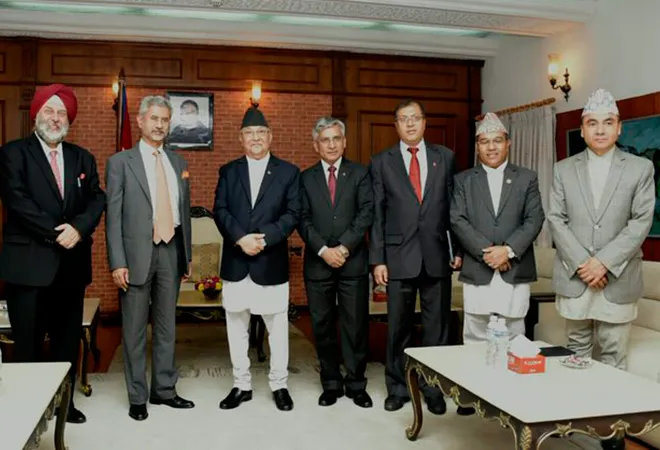
The world has been keenly observing the recent visit of Dr. S. Jaishankar, Minister of External Affairs, India, to Nepal, endeavouring the comprehension of a new turn in Indo-Nepal bilateral dynamics. The occasion is precisely the
Fifth Nepal-India Joint Commission Conference (21-22 August), established in 1987. The visit brings with itself an array of opportunities and geopolitical implications which the two neighbours can cultivate, specifically at a juncture when Indian foreign policy is being closely noted after the abrogation of Articles 370 and 35A with regard to Kashmir, an area of intense contention in South Asia.
The relationship between Nepal and India has often been termed as ‘
special’ for more than one reason. In the South Asian diplomatic theatre, the small landlocked Himalayan country of Nepal is mostly understood as a ‘buffer’ between India and China, the two key giant regional players, who hold within themselves the potential of transforming the entire blueprint of the region as a whole. Given this backdrop, the cordial relationship that Nepal shares with both these powers is noteworthy and predominantly highlighted as a reason for the country to tread rather carefully in the scenario.
In the South Asian diplomatic theatre, the small landlocked Himalayan country of Nepal is mostly understood as a ‘buffer’ between India and China, the two key giant regional players, who hold within themselves the potential of transforming the entire blueprint of the region as a whole.
Dr. Jaishankar is neither unacquainted to the Nepali politics nor is he unaware of an undercurrent of negative sentiment of the Nepalese people towards India, with reference to the blockade of 2015 that has been often remarked as a ‘
humanitarian and economic crisis’ with the acute food shortage as well as the soaring prices of goods. Although New Delhi has denied any such implication time and again, the reflection of the same has been much observed. For instance, from failing or incomplete bilateral projects to the comparatively deeper closeness that Nepal enjoys with China, even in matters of trivial importance like the supply of broadband internet connectivity, which used to be amounted from India. Therefore, in order to maintain and rekindle the amicability of ties, this visit is of utmost importance, arranging for India a fortuity to do away with its ‘hegemonic’ visage, as portrayed by the smaller countries in the South Asian realm, with the new term of the Narendra Modi government in power.
In 2016, Jaishankar, as the visiting Foreign Secretary to Nepal, had made it very clear that the
political stability and development of Nepal along with its prosperity is linked to India’s security. It is indeed time to materialise this vision of collaboration and purposeful partnership. It is meaningful that the conference has been designed to address all the bilateral issues between the two countries that need a deeper understanding along with proper solutions like connectivity and energy. We may assume that the meetings with Nepal’s President Bidya Devi Bhandari, Prime Minister K.P. Sharma Oli and Minister of Foreign Affairs, Pradeep Kumar Gyawali, have been on these lines to make an all-inclusive arrangement benefitting both the countries. One of the most vital issues of concern has been the land and inland water connectivity. This will enable Nepal to carve its own niche in South Asia. Given the landlock situation in which it stands at the moment, this might help Nepal to be heard within the region and taken seriously with respect to its strategic posture. Similarly, it also equally affects India, as the country would always want to have an upper hand in its interactions with Nepal, with the prominent presence of China.
It is meaningful that the conference has been designed to address all the bilateral issues between the two countries that need a deeper understanding along with proper solutions like connectivity and energy.
Identifying issues of land and in-land water connectivity
The geographical situation of Nepal has posed innumerable challenges to the country’s growth. It is not only 70 percent mountainous but is also faced with a
changing course of rivers to its southern lowland plains. For multimodal transportation, trying to cater to its import and export, terminals at Birgunj in Nepal and access to Kolkata and Haldia Ports are noteworthy. Nonetheless, the Kolkata Port has been often regarded as inefficient taking more than seven days to unload the containers from ships and then load it to the rakes. Imports are costly and there is also detention fees associated with it as well, making the situation more complex. Furthermore, the transshipment hubs are also not in a good condition. The Darbhanga-Sitamari-Raxaul rail link, devastated during years flood in North Bihar has been another spirit dampener. Also, it is disorganised.
There are three other railway projects — New Jalpaiguri-Kakarbhitta, Nautanwa-Bhairahawa and Nepalgunj Road-Nepalgunj, which now requires attention. All this is under the India-Nepal Joint Working Group (JWG), finally under a larger subregional framework.
As the border between India and Nepal is open in nature, there is undoubtedly more regulation required. Thus, it is important to reconsider and reframe the
Joint Working Group on Border Management (JWG) and Border District Coordination Committees (BDCCs). The border checkposts like the Panitanki (India), Kakarbitta (Nepal) or Jogbani (India) and Biratnagar (Nepal) need supervision not only to maintain a peaceful border but also to help address issues like illegitimate trade and population inflow and outflow.
As the border between India and Nepal is open in nature, there is undoubtedly more regulation required.
The development of inland river water connectivity also plays a very important role in making the Indo-Nepal collaboration, stronger. In this regard, the vitality of the Kosi river basin must be highlighted, which is capable of bringing about sustainable development for both the countries. To be more specific, this is the only basin that directly connects China, India and Nepal together. In the times of enhanced water politics, the strategic caliber of this area is undoubtedly something noteworthy. There are also transboundary water management programmes that are considered in this regard. This aspect is also hinting at the probability of stronger Sino-Nepal ties as well, that is of much dismay to India but for this case may be of utility in the long run for countering water based natural disasters.
Harnessing a new path
From this overall scenario, India and Nepal must reconsider and reemphasise the crucial position of the BBIN (Bangladesh, Bhutan, India, Nepal) subregional nexus that has somehow lost its relevance in the recent times, primarily after the withdrawal of Bhutan from this framework. In these trying times of failing regional identities like the SAARC (South Asian Association for Regional Cooperation) due to the lack of consensus generation, bilateralism can give way to a new paradigm of likeminded neighbours coming together for the sake of development and peaceful coexistence. Through the BIN, a new strategic sphere can be channelised, opening ahead for Nepal a new world altogether where it can utilise trading routes to its utmost capacity. Also, the idea of ‘dependence’ would wither away with time, as it would be the association of equals, supporting each other in South Asia’s progress. This would be both outward looking as an approach along with all the benefits generated coming home. The Indo-Nepal relationship will have a new meaning.
The views expressed above belong to the author(s). ORF research and analyses now available on Telegram! Click here to access our curated content — blogs, longforms and interviews.



 The world has been keenly observing the recent visit of Dr. S. Jaishankar, Minister of External Affairs, India, to Nepal, endeavouring the comprehension of a new turn in Indo-Nepal bilateral dynamics. The occasion is precisely the
The world has been keenly observing the recent visit of Dr. S. Jaishankar, Minister of External Affairs, India, to Nepal, endeavouring the comprehension of a new turn in Indo-Nepal bilateral dynamics. The occasion is precisely the  PREV
PREV


